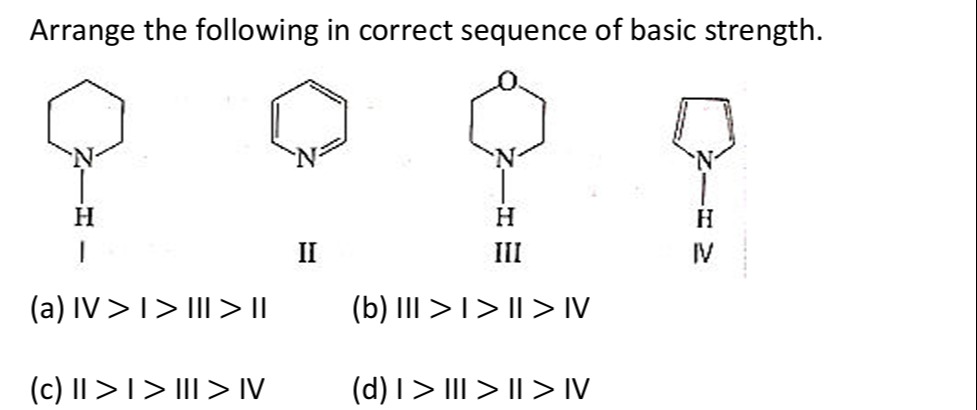Question
Question: Arrange the following in correct sequence of basic strength. ...
Arrange the following in correct sequence of basic strength.

IV > I > III > II
III > I > II > IV
II > I > III > IV
I > III > II > IV
I > III > II > IV
Solution
The basic strength of an amine depends on the availability of the lone pair of electrons on the nitrogen atom to accept a proton. The availability of the lone pair is influenced by factors such as the hybridization of the nitrogen atom, resonance effects, and inductive effects of substituents.
Let's analyze each compound:
I. Piperidine: This is a saturated cyclic secondary amine. The nitrogen atom is sp3 hybridized, and the lone pair is localized and readily available for protonation. II. Pyridine: This is an aromatic heterocyclic amine. The nitrogen atom is sp2 hybridized. The lone pair of electrons is in an sp2 orbital and is not involved in the aromatic π system. However, sp2 hybridized nitrogen is more electronegative than sp3 hybridized nitrogen, which makes the lone pair less available compared to saturated amines. III. Morpholine: This is a saturated cyclic secondary amine containing an oxygen atom. The nitrogen atom is sp3 hybridized, and the lone pair is localized. The electronegative oxygen atom exerts an electron-withdrawing inductive effect (-I effect) on the nitrogen atom, which decreases the electron density on nitrogen and makes the lone pair less available for protonation compared to piperidine. IV. Pyrrole: This is an aromatic heterocyclic amine. The nitrogen atom is sp2 hybridized. The lone pair of electrons on the nitrogen is part of the aromatic π system (contributes to the 6 π electrons that make the ring aromatic). Protonation of the nitrogen would disrupt the aromaticity, which is energetically unfavorable. Thus, the lone pair is very unavailable for protonation, making pyrrole a very weak base.
Comparing the basic strengths:
Saturated amines (I and III) are generally more basic than aromatic amines (II and IV) because the nitrogen in saturated amines is sp3 hybridized, and the lone pair is localized and not involved in resonance or aromaticity.
Comparing I and III: Both are saturated amines. Piperidine (I) has only carbon atoms in the ring besides nitrogen. Morpholine (III) has an oxygen atom, which is electron-withdrawing. The electron-withdrawing effect of oxygen reduces the basicity of morpholine compared to piperidine. So, I > III.
Comparing II and IV: Both are aromatic amines with sp2 hybridized nitrogen. In pyridine (II), the lone pair is not involved in aromaticity. In pyrrole (IV), the lone pair is involved in aromaticity. Therefore, pyridine is much more basic than pyrrole. So, II > IV.
Comparing saturated amines with pyridine: Saturated amines (sp3 nitrogen) are generally more basic than pyridine (sp2 nitrogen). So, I > II and III > II. Since I > III, the order is I > III > II.
Combining the comparisons: I > III > II > IV.
This order is consistent with the pKa values of their conjugate acids: Piperidinium ion (pKa ≈ 11.1), Morpholinium ion (pKa ≈ 8.3), Pyridinium ion (pKa ≈ 5.2), Pyrrolium ion (pKa ≈ -0.2). A higher pKa of the conjugate acid indicates a stronger base.
Final order of basic strength: I > III > II > IV.
